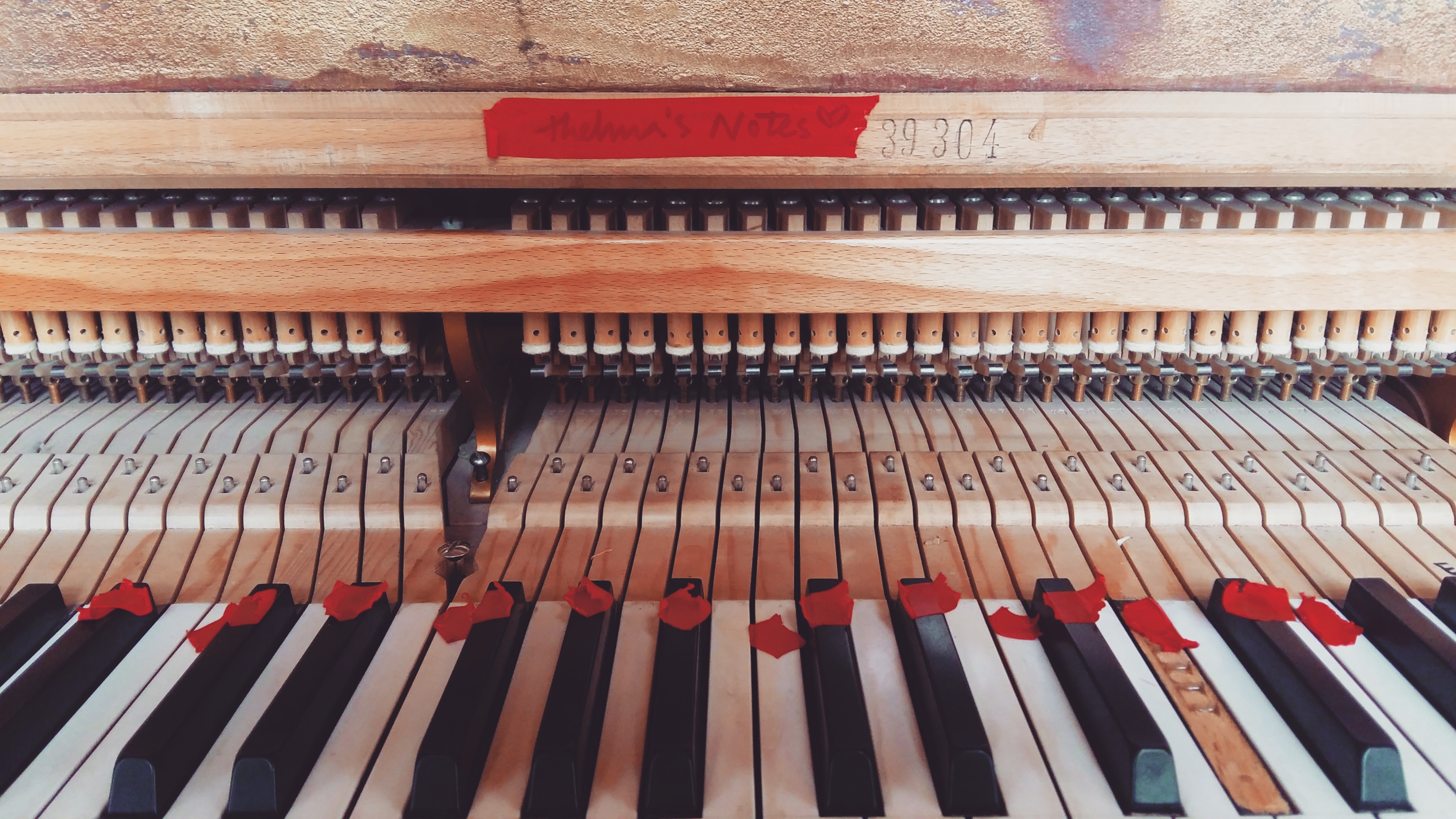meta/morphē is performance art, community art, installation, experimental music, duration piece, recycling project and much more. It first took place in June 2018 in Reykjavik, Iceland, when a group of interdisciplinary artists spent two weeks disassembling a grand piano and re-configuring it into a plethora of material and immaterial objects. The artists were present in various configurations throughout the duration of the project, working both independently and in groups. Performances and performative events of various kinds took place around the central activity of the piano disassemblage, relating to and making use of the piano in many and varied ways.
meta/morphē Facebook page







meta/morphē: “after the form”, from Greek meta (prep.) “after”, “along with”, “beyond”, “among”, “in pursuit of” + morphē (noun) “shape”, “form”, “appearance”, “figure”, “outline”, “kind”, “sort”.
meta/morphē is an act of collaboratively transforming a piano into something else. If the piece had a score, it might read: “Carefully disassemble a piano over a period of time with the assistance of fellow artists and the public. Use the disassembled parts to make new things”. Behind the act is a central question: what comes after the form?
meta/morphē is an inverse Argo. Instead of replacing each piece of the ship until it is entirely renewed, without having changed either its name or form, here the ship is gradually taken apart and the pieces are used to create new forms.
What becomes of the name, after the form? How do we relate to the object during and after its transformation? How does the transformation help us to know our relationship to the (former) object?
























June 8th - 22nd, 2018
Iðnó
Vonarstræti 3, 101
Reykjavík
Artists:
Sophie Fetokaki (maker/performer)
María Arnardóttir (artist/designer)
Einar Torfi Einarsson (composer/artist)
Kristian Ross (composer/sound artist)
Linus Orri Gunnarsson Cederborg (carpenter/musician)
Rebecca Scott Lord (performer/painter/writer)
Taylor Myers (director/performer/immersive theatre maker)
Thelma Marín Jónsdóttir (artist/musician)
Tinna Þorsteinsdóttir (pianist/artist)
General public and passers-by
The form of meta/morphē itself is the combination of the piano and the situation of its disassemblage and transformation. This form constitutes a relationship to the world.
The form of meta/morphē embraces the piano itself, the time of its disassemblage, the social space in which the disassemblage took place, the multiplicity of shoots that sprouted from the work (text, audio, video, photography, performance, interaction, sculpture...) Within this form are sets of relations – between each of the artists; between each individual and the piano; between the various things that are the plethora of the piano; between the piano as it begun and the various artefacts into which it transformed; and so forth.
meta/morphē is performed by a group of individuals who spend long stretches of time together, remaining open to the inclusion of passers-by. It takes as a departure point the notion that “the form of an artwork is a relation to the world,” and that an artist produces “relations between people and the world, by way of aesthetic objects” (Nicolas Bourriaud, Relational Aesthetics).
The piano is the ‘aesthetic object’ by way of which we create relations between one another, and between ourselves and the world. It is the axel of our activity, but it is also merely the occasion for it.

The following are recordings from my daily practice of playing songs and improvisations at the piano as it transformed. I recorded the Aria from Bach’s Goldberg Variations at the close of each day.
The following film documents the 2018 performance of meta/morphē in Reykjavík.
Funded by:


August 26th - 31st, 2019
Kaleido Cultural Centre
Piteå, Sweden
Ung Nordisk Musik Festival
Participants:
Sophie Fetokaki (maker/performer)
María Arnardóttir (artist/designer)
Kristine Bech Sørensen (artist)
Composers, performers and general public of Ung Nordisk Musik Festival 2019
unm.se/2019-festival-schedule/
www.pitea.se/kaleido
The following short fillm was shot on location in Piteå, during the festival. The soundtrack consists entirely of sounds generated with or around the transforming piano.
It was just there, it just stood there, in the end. And I can’t play, no one plays, so it just takes up space. We decided we would try to give it away, we asked everyone in the circle of acquaintances ... Somehow one feels respect for this instrument, which has been very central and given us a lot. One doesn't want to just throw it away. But no one wanted to have it, and we thought in the end that we would have to drive it to the dump, we will have to throw it away. But then you heard about it... And then we also thought it feels a little strange that someone should take it apart and it will sort of disappear into pieces, but it was still better. Now it feels good that it was useful.
Leyla, resident of Piteå and (previous) owner of the (former) piano
︎
not the telos of a process, but the augur of an arrival ︎
